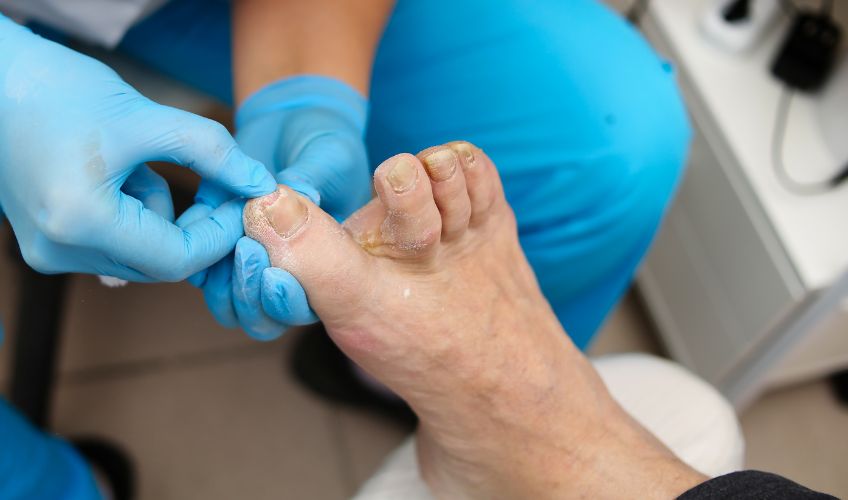
Important: This article is for informational purposes only. Please read our full disclaimer for more details.
Fungal infections in toenails are relatively common and can occur when fungi, such as dermatophytes or yeasts, infect the nail bed. People with a history of getting fungal infections are more prone to it. At the same time, poor circulation, weak immune system, wearing sweaty shoes for a long duration and frequent exposure to a moist environment are some common reasons behind it.
Toenail fungus can cause deformity that can result in pain and discomfort. Luckily, there are various ways to treat it, whether chemical or natural. Hydrogen peroxide is readily used as an effective treatment, and this article will discuss how long it takes for hydrogen peroxide to kill toenail fungus.
Toenail Fungus
Toenail fungus is also known as onchomycosis in medical terms (1). It starts as a small spot and gradually affects nails. The common symptoms of toenail fungus include the following-
- Thickening, brittleness, and crumbling of nails
- Yellow or brown discoloration
- Distorted nail shape
- Foul odor
When infection becomes severe or is left untreated, the affected nail may become detached from the nail bed.(2)
Usually, such infections occur either by moulds, yeasts, or dermatophytes and can spread from one person to the other through shoes, staying in warm and moist places for long or walking barefoot in communal facilities.
Hydrogen Peroxide for Toenail Fungus

Hydrogen peroxide is an effective chemical compound that prevents the growth of toenail fungus (3). It is used as a disinfectant and antiseptic. Hydrogen stops fungal, bacterial, and viral growth and averts toenail disfigurement (4). At the same time, it penetrates the affected area easily, giving effective results.
Here are the ways to apply hydrogen peroxide over toenail fungal growth for maximum relief-
Step 1: Wipe off the infected area with a clean cloth or cotton swab.
Step 2: Apply hydrogen peroxide to the infected area in these two different ways-
- Dilute with water: Mix a small amount of hydrogen peroxide with water to reduce its harshness. Now, soak your feet in it for a few minutes. Pat dry with a clean cloth. Here, it is recommended to not use hydrogen peroxide beyond 3 percent concentration.
- Using cotton swab: Dip a cotton swab in hydrogen peroxide and apply it over the fungal growth. Ensure that the surrounding skin does not come in contact with hydrogen peroxide.
Beside the anti-fungal properties, hydrogen peroxide also offers a cleansing effect when applied on the skin or nails. It removes debris, dirt, and dead tissue from the affected toenail; thus, helping in creating a cleaner environment that is less hospitable to fungal growth.
Time Taken by Hydrogen Peroxide to Heal Toenail Fungus

The time taken by Hydrogen peroxide to heal toenail fungus depends on a number of factors, among which the severity of the fungal infection (5) is the most prominent. The duration may vary from several days to several months. However, regular use will result in quicker recovery.
Here are the factors that influences time taken by hydrogen peroxide to heal toenail fungus-
- How severe is the infection: While mild cases will resolve quickly and you can see improvement within a few weeks, moderate and severe cases will take more time, over a month or two for complete healing.
- What’s the consistency of the treatment: If you want to achieve the results fast, you need to be consistent to apply hydrogen peroxide to the affected nails. Skipping treatment will eventually prolong the healing.
- What’s the duration of treatment: Usually, hydrogen peroxide takes extended time to clear the infection and show visible results. How long you have been taking the treatment decides how long hydrogen peroxide will take to show results. It is essential that all the fungal spores are eradicated.
Additionally, dermatologists recommend using hydrogen peroxide for several months after recovery to prevent further infection and ensure complete healing. It is also important to understand that a complete recovery may not be guaranteed even after continuous use if the condition is severe.
In such cases, you may need combination therapy, that is, using hydrogen peroxide may be used in combination with other treatments to enhance efficacy and speed up healing.
Precautions and Side Effects
It is of vital importance that you take certain precautions while using hydrogen peroxide to ensure safety. Also, understanding the side effects of its usage will help to decide whether to use it or not.
- Conduct a small patch test before application to the entire fungal area to test the skin sensitivity towards hydrogen peroxide.
- Hydrogen peroxide is not recommended for use on open wounds.
- Consult a health care expert if you notice any adverse reaction to using hydrogen peroxide.
- Practice good hygiene to avoid the spreading of fungal infection.
Conclusion
Toenail fungus causes discomfort and is painful. It also can get severe and spread unless treated on time. Since toenail fungus can cause hindrances in daily activities like walking or moving, you need proper care and effective treatment as soon as possible.
Hydrogen peroxide effectively treats toenail fungus and provides the best results. To enhance its effectiveness, it is important to use proper technique and the correct proportion and amount.
Image Source : canva
Related Articles
- The 10 Best Home Remedies for Toenail Fungus
- How to Get Rid of an Ingrown Toenail at Home?
- How to Prepare an Apple Cider Vinegar for Toenail Fungus?
- 19 Stylish Toe Nail Ideas for Fall 2024
- Tea Tree Oil to Treat Toenail Fungus: How to Use?















